Im only a bit Welsh, but have long wanted to try a coracle. Here
is a plywood one, as the bullock ran away when I tried to skin it for the
hull covering. It is about 50 long and 42 beam and draws about 5 on a
flat but rockered bottom. The bottom edges of the buoyancy tank sides give
the shape to the bottom.
|
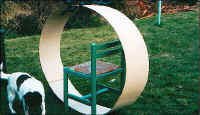
The savage dog guards the
12 foot hoop of 4mm ply.
(click to enlarge) |
All joints are glued with half hour PU in a cartridge. All seams
except the butt straps are glass taped remember to do the chine glassing
before fitting the buoyancy tank lids. Joints are stapled, or sometimes
held with copper ties. The chine staving was just wedged in place, with a
cross of masking tape to hold each stave in place while the glue dried.
All metal fastenings are removed before glassing. There is no drawing as
the photos show how she goes together. A drawing of the bottom curve is
available.
|
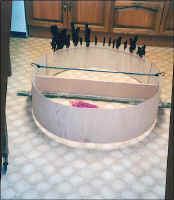
Laminate gunwale...
(CTE) |
The procedure is to cut three 11 inch wide strips across the 4 foot
of a sheet of 4mm say 3/16 ply. Use 4 wide butt straps to make a 12 ft
length. Form into a circle, butt strap again, using the top rail of the
chair to staple against. Hold the hoop to the 42 beam with batten, with a
butt strap at one end. Laminate 3 thicknesses of 2 strips, two inside one
out to make gunwale. Decide how wide you want the central channel, (I
opted for 22) and cut two longitudinal bulkheads. The bottom edge of
these gives the shape of the bottom. The bevel at the bow is 3 x 3, at the
stern a shallower 3 x 6. The tail of the bottom between the bulkheads is
pulled towards the
|
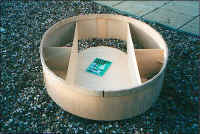
...add bulkheads and bottom -
bow to the rear. (CTE)
|
gunwale by a Spanish windlass to ease the run aft. The bottom is
bluffer at the bow, as thats where we want the buoyancy so we can lean
forward to put the power in. We want an easy run aft to let the water out
from underneath the boat. The butt strap is at the stern. I used 2 wide
strips to plank (or stave) up the chine gap. The buoyancy tank tops fit
just under the gunwale. I made four handles by fitting a ½ square strip
inside the inboard top edge of the buoyancy tanks, and making a handle
like the ones on big speakers, a sort of motorcycle handlebar knuckle
protector. (see picture of Lewis below). The waterline is painted 1 Ό
inches up from the chine.
|
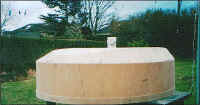
Chine staves glued and
sanded
stern view. (CTE)
|
The boat is amazingly stable. The stroke is really interesting. It
starts as a sculling motion, but the boat swivels with each stroke. To
counteract this, the stroke becomes a more pronounced figure of eight, and
you twist your hips and use the impulse of each stroke to counteract the
swivel of the next
..look, just do it, ok?
|
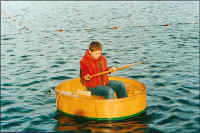
Grandson Lewis is very
daring
(click to enlarge) |
The boat will almost fit inside my little car so it ought to be lost
in the average American one. You could probably get about half a dozen in
the back of a pickup. It might be quite a practical boat to fish out of
with a rod & line. The Welsh used to use them for setting out Salmon nets,
until the practice was banned as they virtually exterminated the Salmon
from the Welsh rivers!
|
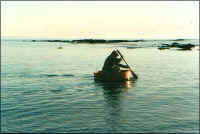
And I paddle off with
Arran in the
background note wake! (CTE) |
|